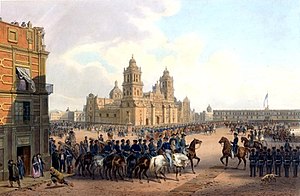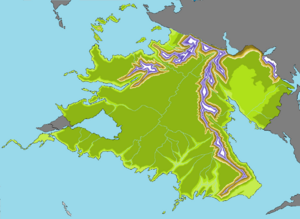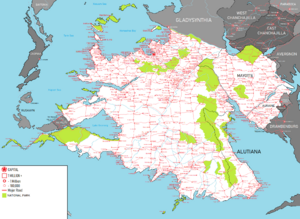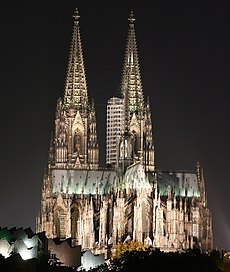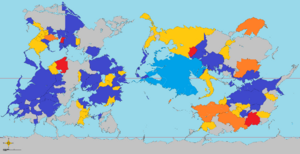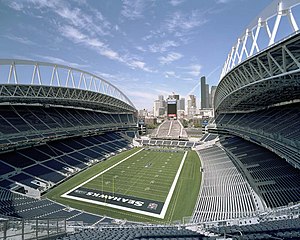Zamastan
Imperial Republic of Zamastan Zamah St'an | |
|---|---|
| Motto: Long Live the Republic | |
| Anthem: Ode to the Mount
| |
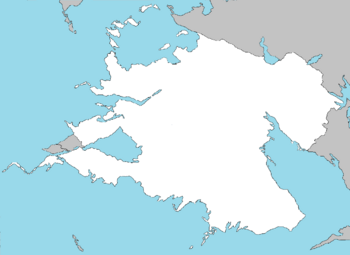 | |
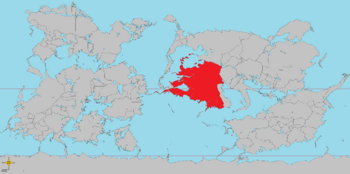 Location of Zamastan (red) on Iearth | |
| Capital | Tofino |
| Official languages | None at federal level |
| Recognised national languages | Zamah St'ani-English, Zamah St'ani-French |
| Recognised regional languages | Zamah St'ani-Spanish |
| Ethnic groups (2016) | Skithan, Caticeze, Drambenburgian, Avergnonian, Gladysynthian, Quetanan, Palitoan |
| Demonym(s) | Zamastanian |
| Government | Democratic Republic |
| Atticus Moreau | |
| Natasha Chastain | |
| Jessiah Vallotis | |
| Camille Boffrand | |
| Mara Orlandi | |
| Josephine Champernon | |
| Establishment | |
• Catican Zamah St'an | circa 200 B.C.E. |
• Republic of Zamah St’an | October 28, 1804 |
• Imperial Republic of Zamastan | September 22, 1844 |
| Area | |
• Total | 9,984,670 km2 (3,855,100 sq mi) (1st) |
• Water (%) | 8.92 |
| Population | |
• 2020 estimate | 360,054,000 (2nd) |
• Density | 277.72/km2 (719.3/sq mi) |
| GDP (nominal) | 2020 estimate |
• Total | 21.377 trillion (1st) |
• Per capita | 59,733 |
| Gini (2016) | 46.9 high |
| HDI (2016) | 0.91 very high |
| Currency | Zamastan ziapet/dollar |
| Date format | mm-dd-yyyy |
Zamastan, officially known as the Imperial Republic of Zamastan (French: L'République Impériale d'Zamastan) is a democratic republic located on the continent of Euronia in the Coalition of Crown Albatross. It is bordered by Gladysynthia to the north, Mayotte and Alutiana to the east, and Rio Palito to the west, as well as maritime borders with Ruskayn, Caspia, Baytonia, and Quetana. It has the world's longest coastline with overwhelming access to the Olympic Ocean and Toyana Ocean. Zamastan also has possession of two overseas territories: the Holish Islands in the Southern Samson Ocean and the island/city of Gangkou off the coast of Yuan. By geographical area, it is the largest country and second most populated on the planet Iearth after Yuan.
With its Administrative Districts having a combined population of 360 million people, it is considered to be one of the most powerful economic and political influences in the world. The capital of Tofino is the largest city in the country as well as one of the largest metropolitan areas in the C.C.A.. Other major populated metropolitan areas in Zamastan include Arinals, Emerald, Providence, and Titania, while population centers in historically older settlements with limited space such as Lower Tariel and Kelowna being other significant regional cities, and cities with relatively smaller populations, such as Moulins and Fougere, are famous for their cultural settings. As a whole, Zamastan is sparsely populated, the majority of its land area being dominated by forests, prairies, and mountains. Its population is highly urbanized, with over 80 percent of its inhabitants concentrated in large and medium-sized cities, and 50 per cent residing within 100 kilometers (62 mi) of the oceanic border.
Various Catica First Nations tribes have inhabited Zamastan since around 10,000 B.C.E., and a region called Zamah St'an formed and was documented around the western coast around 200 B.C.E.. It was isolated for over 1,900 years before Percy Armillio discovered the region in the early 1700's. Zamastan's colonists won independence from Skith in 1804 and formed the modern day nation, which became an important player on the world stage in the 19th and 20th centuries. Zamastan became a global superpower following their victory in the World War in 1954, their testing and deployment of the first nuclear weapons, and their strong economic, militaristic, and diplomatic relationships with the rest of the world.
Zamastan has advanced rapidly in the fields of technology, expanding their influence into space with their contributions to the Coalition Space Station, while maintaining the steady economic gains of mining, logging, and fishing. Zamastan is known for its rich history, stunning natural beauty, and rich living tolerances. Politically, most executive leaders are moderate, with fiscal conservative views with defining liberal views for social issues. Same-sex marriage was legalized in 1982, and the proposition for legalization of marijuana has been heavy pressed for years. Tax rates tend to be low thanks to the thriving economy and relative consensus on the ease of wages and minimum pay. Zamastan is a highly developed nation, with high standards of living, a sizable military in the Zamastanian Armed Forces, and an extensive government serviced through numerous federal departments. It is also a member of multiple international alliances, such as the Western Euronia Defense Alliance, the Coalition Trade Organization, the Collective of 21, and others.
Recently, Zamastan has experienced political turmoil over the resignations or removals of several high-profile politicians, specifically Presidents. Currently, the President of Zamastan is Atticus Moreau, who succeeded Foley Sakzi in the 2020 presidential election. Sakzi was elected following the removal of Anya Bishop. Bishop was elected on January 23rd, 2019, following an emergency election to replace the resigning Zacharias Castovia, who had been in power since 2016 following the death of his predecessor and father, Cassious Castovia. Following the Bettencourt Protests, three provinces (Mayotte, Aunistria, and Alutia) seceeded from the country and formed the independent nations of Mayotte, Auraine, and Alutiana on January 1st, 2021. Zamastan was the founding member of the Coalition of Crown Albatross.
Etymology
While a variety of theories have been postulated for the etymological origins of Zamastan, the name is now accepted as coming from the Catica First Nations words Zamah St'an (pronounced zah-mah-stay-ahn), meaning ‘land touching sky’ and ‘extensive shores’. The name of the Skith colony in Euronia was named Zamah St'an, following the native's discussions and origination of the land. However, upon independence following the Revolution of 1804, the nation was more simply named Zamastan (pronounced zah-maas-taan), which abbreviated the syllables. The standard way to refer to a citizen of Zamastan is as a "Zamastanian."
History
Main article: History of Zamastan
Pre-Discovery (10,000 B.C.E.-1700 A.D.)
Human development and migration
Zamastan is considered by most paleoanthropologists to be the oldest inhabited territory on Iearth, with the human species originating from the continent. During the mid-20th century, anthropologists discovered many fossils and evidence of human occupation perhaps as early as 7 million years ago (BP=before present). Fossil remains of several species of early apelike humans thought to have evolved into modern man, such as Australopithecus afarensis (radiometrically dated to approximately 3.9–3.0 million years BP, Paranthropus boisei (c. 2.3–1.4 million years BP) and Homo ergaster (c. 1.9 million–600,000 years BP) have been discovered.
After the evolution of Homo sapiens approximately 350,000 to 260,000 years BP in Zamastan, the continent of Euronia was mainly populated by groups of hunter-gatherers. These first modern humans left Zamastan and populated the rest of the globe during the Second Great Iearth Migration migration dated to approximately 50,000 years BP.
Early civilizations
Over time, indigenous cultures in Zamastan grew increasingly complex, and some, such as the Catica First Nations (Kelowna) culture in the northwest, developed advanced agriculture, grand architecture, and state-level societies. The Kelowna culture flourished in the south from 800 to 1600 AD, extending from the Gladysynthian border down through Rio Palito. Its city state Kelowna is considered the largest, most complex pre-historical archaeological site in modern-day Zamastan.
In the east, the Kingdom of Mayotte formed with the collective federations of other kingdoms in 1200 AD. The Second Drambenburg Empire and the Kingdom of Mayotte fought the Fifty Years War from 1337-1389 due to each side claiming legitimate power over the palatinate of Aunistria. Aunistria was ultimately conquered by Drambenburg.
18th-19th Centuries
Skith Colonization (1704-1800)
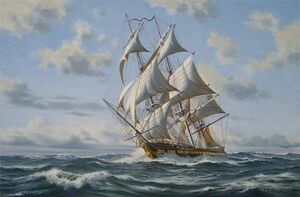
The land that would come to be known as Zamastan was first colonized in 1704 by Percy Armillio, a Skithan national and explorer who stumbled upon the land inadvertently during one of his expeditions on behalf of the Skithan Empire. The Empire was a major world power at the time and was in the process of expanding its imperialist ambitions to the New World where they had already established multiple colonies in Quetana, Raviannas, and Rio Palito. Aboard Armillio's ship traveling with him were a crew of approximately 100 men brought along to assist Armillio upon landing near Kelowna as well as an additional hundred Ski'ah Highland slaves. The captive men were sent over from the Skithan mainland with the intended task of performing slave labor to assist in the construction of the colony in Zamastan.
Zamastan War of Independence (1802-1804)
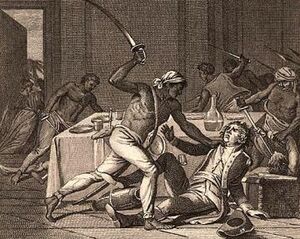
From July 17th, 1802 to October 28th, 1804, rebelling slaves and colonists led by Tomias Hapson and Avi Taures fought an insurrection against the Skith Empire, eventually repelling them to abandon the colonies. The Zamastan War of Independence was the first known successful colonial war of independence against a foreign power. Zamastanians had developed an ideology of republicanism and abolitionist attitudes towards slavery, and once the Skith were expelled, Tomias Hapson, a former slave himself, was elected the first President of Zamastan.
Early Expansion
Hapson's nearly two decades of undertakings saw a major expansion of Zamastan's borders, as well as a massive industrial boom. The colonies of Jurrania, governed by former Skith commanders and generals, were conquered in 1807. In 1824, Pahl was annexed with the Pahlan Purchase of 1824, which paid the Empire of Gladysynthia Z$400 million to allow for the territory, more than doubling Zamastan's size. Moulins, which would later be called Redeemer’s Land, was purchased in a similar fashion in 1831. Hapson's assassination in 1821, on the 17th anniversary of independence, was followed by Avi Taures' assention to the Presidency, and he propelled Zamastan into a further decade of economic prosperity.
In 1850, Zamastan was victorious against Kingdom of Lousianian in the Louise Mountains War and as a result annexed their territory. The annexation placed Zamastan's borders at that of the Kingdom of Mayotte, which had been conquered by the Empire of Paraboca.
The Parabocan War (1871-1876)
On January 5th, 1871, the Empire of Paraboca invaded Zamastan through occupied Chanchajilla. Zamastan and President William Castovia were untested in conventional war and were caught off guard, relying heavily on large-scale attacks and even Ruskaynian mercenaries to help fend off the invading forces. The war tested Zamastan's small army by promoting the first draft of soldiers and the concern of being conquered by a foreign power. Hundreds of thousands of soldiers were killed during the war, and the death toll for civilians in Zamastan was also staggering, as the Parabocan soldiers were notoriously violent. When the war ended, Paraboca went into political upheaval and turmoil, leading to the collapse of the nation in 1879, three years after the war ended. Paraboca would remain in a state of civil disarray and conflict until 1910, when they federalized their government and reorganized, including establishing diplomatic relations with their neighboring countries.
The victory and territorial expansion following the war William Castovia envisioned inspired great patriotism in Zamastan, but the war and treaty drew some criticism in Zamastan for their casualties, monetary cost, and heavy-handedness, particularly in the later stages of the war when the Parabocan armies had began their retreat. Mayotte became part of Zamastan's territory following the war in 1876.
In 1881, the Kingdom of Tregueux was annexed, and two years later the Kingdom of Verdesia was also annexed. These two territorial gains gave Zamastan complete territorial control of southwest Euronia and a commanding coastline on the Toyana Ocean stretching from Titania to the Quetana Pass.
Early 20th Century
In 1904, Arbery Jacob Henderson achieved the first heavier-than-air flight in a motor-powered airplane. The Verdusa crisis of 1907 saw President Thomas Dubois impose a naval blockage against Verdusa from April 8th to November 6th, 1907, after the government of Verdusa refused to pay foreign debts and damages suffered by Zamastanian citizens in recent civil wars. In 1911, a collective of 2 rogue army generals and roughly a hundred followers attempted to overthrow the government of President Jean Levasseur and install a military regime, but were defeated.
Natural disasters, such as the 1923-24 Pahlan Drought, which killed over 15,000 people, and the 1919 Tofino Earthquake, which killed over 75,000 people across the northwest coast, threw Zamastan's cultural perspective into a new light of social unity. President Hawk Gardner introduced the nation's first refugee acceptance program, leading to mass immigration to Zamastan in the early 20th century.
Blanco Initiative and the 1934-41 Economic Crisis
Rapid economic development sponsored by President Elias Blanco's Blanco Initiative fostered the rise of many prominent industrialists. Tycoons like Frank Rabernath led the nation's progress in railroad, petroleum, and steel industries. Banking became a major part of the economy, with Arinals Bank playing a notable role. Zamastan undertook the widespread distribution of electricity to industry, homes, and for street lighting, and revolutionized the automotive industry. The economy boomed, becoming the world's largest, and Zamastan achieved great power status. These dramatic changes were accompanied by social unrest and the rise of populist, socialist, and anarchist movements. This period eventually ended with the advent of the Progressive Era, which saw significant reforms in many societal areas, including women's suffrage, alcohol prohibition, regulation of consumer goods, greater antitrust measures to ensure competition and attention to worker conditions. In addition, a major market crash in the form of the 1934-41 economic crisis threw Zamastan's economic balance into limbo at the turn of the 1930s-40s, leading to a shift towards a liberal institution in the election of President Tyler Kordia
First Danaska War

President Kordia's policies surrounding taking economic-advantages from raw resources led to the seven-day Danaska War in 1945. Gladysynthia had recently broken apart from its imperial reign and had newly formulated into a Republic, but was faced with the war path from President Kordia and his ambition was to conquer the oil rich territory of the Northern Isle and the Danaska region. As the Premiere of Gladysynthia, Laurence Clarkson, rallied his troops, tensions became dangerously heightened. In addition, the Chanchajillan Civil War, which ended a year earlier, furthered the separation between the two nations as Zamastan supported the republican nationalists and Gladysynthia supporting socialists. On August 2nd, Zamastan launched what it claimed were a series of preemptive airstrikes against Gladysynthian airfields. The Gladysynthians were caught by surprise, and nearly the entire Gladysynthian air force was destroyed with few Zamastan losses, giving the Zamastanians air supremacy. Simultaneously, the Zamastanians launched a ground offensive into the city of Danaska and Tariel Heights, which again caught the Gladysynthians by surprise. After some initial resistance, Gladysynthian leader Laurence Clarkson ordered the evacuation of Danaska. Zamastan forces rushed westward in pursuit of the Gladysynthians, inflicted heavy losses, and conquered the Danaska region.
Gladysynthia agreed to a joint ceasefire on August 9th. In the aftermath of the war, Zamastan had crippled the Gladysynthian military, having killed over 20,000 troops while only 3,000 of its own were lost. The Zamastan success was the result of a well-prepared and enacted strategy, the unprepared leadership of the Gladysynthian states, and their poor military leadership and strategy. Zamastan seized Danaska and the Tariel Heights from Gladysynthia. The speed and ease of Zamastan's victory would later lead to a dangerous overconfidence within the ranks of the Zamastan Defense Forces (ZDF), contributing to initial Gladysynthian successes in the subsequent Tariel War, although ultimately Zamastanian forces were successful and defeated the Gladysynthian military. The displacement of civilian populations resulting from the war would have long-term consequences, as 300,000 people fled Danaska and about 100,000 Zamastanians left the Tariel Heights to become refugees.
Late 20th Century
Marvin Gaviria, elected President in 1946, is considered to be one of the most popular presidents in the history of Zamastan, overseeing a flourishing economy during a tumultuous time in history. His strong economic stances against communism including crippling sanctions propelled the nation into the new world with new jobs programs and a uniquely revitalized education system. The President was also known for his endeavors on the international stage in diplomacy, creating some of the first ever trade connections with other nations such as Vulkaria, Tinten, and Cadair.
The World War
Despite his pursuits of peace, Gaviria was forced to send Zamastanian forces to assist Avergnon in 1949 when the Empire of Drambenburg invaded their allies and began brutal bombing campaigns of major civilian areas. The early stage of the war was slowly and grueling, as each side was unable to gain major advances of territory and resorted to intense tit-for-tat campaigns against civilian populations, such as the razing of Titania during a Drambenburgian firebombing raid on October 19th, 1949. Eventually Drambenburg shifted their tactics to the Toyana Ocean, where they targeted shipping vessels of neutral nations in an attempt to deter nations from entering what was Grand Kaiser Geoff III von Wettin's strive for an expansive territorial empire. This ultimately backfired, bringing Quetana, Albarine, Caspiaa, East Besmenia, and Emmiria into the war on Zamastan and Avergnon's side, which would be known as the "Allies". Drambenburg's allies, which included Barangadesh, Styrae, and Rumaztria, were known as the League.
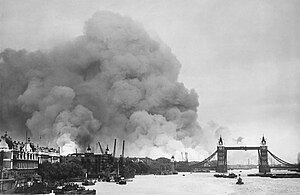
The main contributions of Zamastan to the Allied war effort comprised money, industrial output, food, petroleum, technological innovation, and (especially 1951-1954) military personnel. Much of the focus in Tofino was maximizing the economic output of the nation. The overall result was a dramatic increase in GDP, the export of vast quantities of supplies to the Allies and to Zamastanian forces both fighting along the Drambenburg and Avergnon borders and overseas, the end of unemployment, and a rise in civilian consumption even as 40% of the GDP went to the war effort. This was achieved by tens of millions of workers moving from low-productivity occupations to high-efficiency jobs, improvements in productivity through better technology and management, and the move into the active labor force of students, retired people, housewives, and the unemployed, and an increase in hours worked.
Upon the addition of the Dominion of the Sanguine Church in the conflict in 1950, Zamastanian and East Chanchajillan forces were able to create a new battlefront, which allowed for eased fighting for the Avergnonians. However, the DSC and Rumaztria, both League Powers, swept into the Allied nation of Vulkaria, nearly completely capturing the nation and threatening vital supply routes through the Vulkarian Pass.
Zamastanian armies participated in the liberation of Vulkaria from the DSC and Rumaztria in 1952-1953 during Operation Pelican Spanning alongside Vulkarian, Emmirian, and Ruskaynian troops. Landing on both ends of the country, Zamastanian forces fought back Sanguine fighters in the north and contingents of Rumaztrians in the south, with Ruskaynians reinforcing in the north and Emmirians to the south. The fighting in Vulkaria was particularly devestating, with the Battle of Sennepal alone costing more than 20,000 lives. By the spring of 1953, Rumaztrian forces had been fully expelled from the southern end of the nation and signed an armistace, effectively dropping out of the war and ending one of three fronts. In June, the DSC was defeated in Vulkaria and two months later in August on the Eastern Front, also signing an armistace and ending the conflict in Vulkaria and Eastern Avergnon. The only battle zones left were now limited to Drambenburgian controlled territory.
The final invasion of Drambenburg began in January of 1954, which saw some of the most violent fighting in the conflict. The final member of the League Powers ultimately surrendered on November 12th, 1954, with the condition that the allied forces spare the capital of Lerbin. 289,430 Zamastanians were killed during the course of the war and over 859,044 were wounded, making it the second-deadliest war in national history after the Parabocan War. Aunistria was annexed by Zamastan after the war.
Post-World War
Coalition of Crown Albatross and the Civil Rights Movement
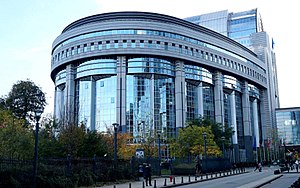
Following the World War, President Gaviria also oversaw military operations in the Pahl Region of Zamastan, where the military fought small pockets of pro-communist insurgents. In 1970, Gaviria was faced with a sudden and sporadic outbreak of fighting in The Tariel War, seeing the Zamastanian Armed Forces pitted against the invading Gladysynthian forces.
On September 29th, seven days after he was elected to his 13th term, Marvin Gaviria was assassinated during a speech at Congressional Hall in Tofino, and Elene Abotsford was elected as the first female-President of Zamastan. Abotsford proposed and created an international organization known as the Coalition of Crown Albatross. At home, Zamastan experienced sustained economic expansion and a rapid growth of its population and middle class. Construction of an corss-provincial highway system transformed the nation's infrastructure over the following decades under the presidencies of Aiden Avery and Quinn Werner. Millions moved from farms and inner cities to large suburban housing developments. The growing Civil Rights Movement used nonviolence to confront segregation and discrimination against religious intolerance and sexual-identification movements. However, the later half of the 1970s, 1976 in particular, was marked by the 1976 Barangadesh hostage crisis, the refugee crisis caused by the 1976 Vulkaria Earthquake, the Helios Island nuclear accident, and the shootdown of Zian Airways Flight 127 by Beleroskov. In response to the shootdown, President Abotsford escalated the tensions with the Ausiana communist powers, including Yuan, further when she ended détente, imposed a grain embargo against Beleroskov, and led a boycott against the 1976 Koyevka World Cup.
The sudden death of President Damian Lorrie in 1982 put Cassious Castovia in the Presidency. Though most of his first official duties as President for the first quarter of his first term (6 months) were merely social issues, the Supreme Court and the Congressional members of the government discussed a growing trend in the global community – that of legalizing gay marriage. The LGBT community around the world had started gaining momentum, specifically in the fact that laws outlawing homosexuality were being abolished in many C.C.A. nations such as Quetana, Rio Palito, and Austrolis around the 1980s. On June 4th, 1983, Castovia signed a bill that allowed for individual counties to allow their own passage of same-sex marriage. This was a hotly disputed act, but it progressed Zamastan’s social climate further towards the adapting world.
The Vulkarian Wars
The First War in Vulkaria, at the time known simply as the Vulkarian War was a military conflict in the nation of Vulkaria. A coup d'etat that attempted to overthrow the capitalist government in 1982 resulted in violent retaliation by the splinter groups of the rebel Marxist group known as the Malvarian Liberation Front. Following the 1983 Alanis Pride Parade Bombing and several other terror attacks in Zamastan, the government of Zamastan under President Castovia sent in a fighting force to help the government of Prime Minister Eugenia Charles destroy the M.L.F.. The nearly 8 year long war ended with the Malvarian terrorists fleeing the country in a sudden exodus.
Following the events of the First War in Vulkaria and the sporadic protests and violence that persisted throughout the next decade, a government policy regarding capitalist and global economics installed in 1999 led to a revitalization of the M.L.F. and many other embattled groups wanting to take over power from the federal government in order to install a Marxist regime. A civil war erupted in 2000 once again, and the nation was embroiled with global interests once again being threatened in the form of trade along the Elkjop Bay and the Strait of Vulkaria shipping routes, as well as the threat of terror attacks being experienced by many of the nations involved in the coalition efforts.
President Castovia sent troops into Vulkaria once again in 1999 to aid the Vulkarian government, and in 2000, the international coalition joined the fight. The war ended in 2005 with the surrender of rebel forces and a signed treaty by the Federal forces and Coalition observers to allow small territorial governance by M.L.F. and V.N.A. forces.
The Second War in Vulkaria was staggering in terms of the death toll, with over 2.3 million people killed, over half of them citizens. Vulkaria lost over 103,000 soldiers. The Coalition forces lost a total of 7,153 troops.
Rise of Conservatism and Foreign Interventions
Cassious Castovia produced a major realignment towards conservatism in his 1984, 86', and 88' landslide elections, a significant achievement considering Zamastan was embroiled in the First War in Vulkaria. Castovia's economic policies and the implementation of the Economic Recovery and Stimulus Act of 1984 lowered the top marginal tax rate from 50% to 23% over the course of seven years. Castovia continued to downsize government taxation and regulation. Zamastan experienced a recession in 1992, but the negative indicators reversed, with the inflation rate decreasing from 11% to 2%, the unemployment rate decreasing from 10.8% in December 1992 to 7.5% in November 1994, and the economic growth rate increasing from 4.5% to 7.2%.
Castovia ordered a buildup of the Zamastanian Armed Forces, incurring additional budget deficits. Beyond the military operations in Vulkaria, Zamastanian troops also interfered in the Verdusa Civil War (1987-89), as well as in the Chezian War (1992-95), conducting operations alongside C.C.A. peacekeepers in Constantio, Cechena, Syraranto, and Achijan. Zamastanian Intellience Service operatives also embeded alongside rebel forces in Jaginistan during the Jaginistan Civil War which saw operations against Beleroskov-backed government forces.
The Blue Conservative Party expanded its base throughout the country, especially in more rural areas and french-speaking provinces after 1976 (with the election of Aiden Avery, largely due to its strength among socially conservative white Evangelical Protestants and traditionalist Verdusan Catholics, added to its traditional strength in the business community and suburbs. As white and Christian liberals in the rural areas lost dominance of the Green Liberal Party in the 1990s, the region took on the two-party (sometimes three or four) apparatus which characterized most of the nation. The Conservative Party's central leader by 1980 was Cassious Castovia, and the party's conservative policies called for reduced government spending and regulation, lower taxes, and a strong anti-Beleroskov, Drambenburgian, and Yuaneze foreign policy.
Modern Day (2010-present)
The province of Mayotte underwent profound social and economic changes through the Quiet Revolution of 2011-12, giving birth to a secular nationalist movement. The radical Front de libération du Mayotte (FLM) ignited the August Crisis with a series of bombings and kidnappings in 1970 and the sovereignist Mayottean Party was elected in 2011, organizing an unsuccessful referendum on sovereignty-association in 2012. Attempts to accommodate Mayotte nationalism constitutionally through the Louise Lake Accord failed, leading to the formation of the Bloc Mayotte in Mayotte and the invigoration of the Reform Party in the West. A second referendum followed in 2013, in which sovereignty was rejected by a slimmer margin of 50.6 to 49.4 percent. In 2014, the Supreme Court ruled unilateral secession by an Administrative District would be unconstitutional and the Clarity of Provincial Secession Act was passed by Congressional Hall, outlining the terms of a negotiated departure from Republic. On May 9th, 2020, the provinces of Mayotte and Aunistria passed a autonomy-grant referendum that gave the two provinces substantial autonomy from the federal government. The decision, which came within 84,000 votes, was extremely controversial as there were suspicions of vote tampering, and as many nationalist members of both provincial legislatures tried to pass drafts that would have declared independence.
President Castovia died of Brugeda Syndrome on December 5th, 2015, leading to an emergency election in which his son. Zacharias Castovia, assumed the presidency. A series of terrorist attacks in Zamastan reinvigorated tensions with insurgent forces in Vulkaria and now Malvare, leading to Castovia's decision to fully sanction Malvare. On October 24th, 2018, the Gladysynthian vessel GMS Lockwood fired on the city of Lower Tariel on the Zamastan controlled Northern Isle. Though no one was injured, the attack was enough for Castovia to approve airstrikes on Gladysynthian airbases. Eventually, the conflict escalated to a much more violent all-out-war. Zamastanian troops invaded the city of Danaska, and held position for nearly a week. However, mounting casualties and unpopularity of the conflict back home led to Castovia's decision to retreat, with the condition that Gladysynthia cease hostilities on the Northern Isle, release prisoners, and remove blockades. The Third Danaska War officially ended with a visit by Castovia to Mönusÿnthys to meet with Premiere Seswitch LaFlaunce. This was seen by many as the low point of Zacharias Castovia's Presidency, as over 400 Zamastanian and 700 Gladysynthian troops were killed for a fight that ended up not producing any changes in policy and being relatively worthless.
On January 22nd, 2019, Castovia resigned from the presidency following the Delavian Bribery Scandal, which resulted in some congressmen and prominent business being arrested and charged, and though Castovia himself was cleared of any wrongdoing, the stain from the event had shaken his administration. An emergency election was held, and Anya Bishop became President. During her presidency, she oversaw a period of economic downturn for which she was blamed by both sides of the political spectrum. Bishop famously lashed out against liberal party members who criticized her on her policies. Following an order in which she dispatched military forces against protesters, she was condemned by both the Congress Chamber and the Senate and was then voted out of office through a vote of no-confidence. An emergency election followed, putting Speaker of the Chamber Foley Sakzi in power.
Beginning in April 2020, a series of naval detainings and missile attacks on international vessels prompted heightened tensions between Zamastan and Ossinia in the Ossinia Sea. On May 15th, dozens of ORNF speed boats harrased the ZMS Maple Wind in Zamastanian territorial waters in a move called "dangerous and provocative" and "increased the risk of miscalculation and collision" by the Zamastanian Naval Forces.[1] A missile attack occured the next day on the ZMS August Vendetta, killing seven sailors and increasing hostilities even further. A Zamastanian container ship, the MV Galen Schulz, was struck by a missile the day following, suffering fatal breaches in the ship's hull that caused it to eventually sink. When Secretary-General of the C.C.A., Katherine von Wettin, removed Ossinia's seat in the General Assembly, Congressional Hall granted Sakzi with expanded military powers to act against Ossinia. On May 24th, Zamastan invaded Ossinia, rapidly knocking out its military capacity in less than 24 hours. The capital of Périnnois was occupied, and President Martin Saint-Yves was captured by Zamastanian forces on May 27th. He was taken back to Zamastan and tried alongside other members of the regime in the Tregueux Trials. Zamastanian forces remained in an occupational capacity until July 31st, when the interim Ossinia government took power.
In July and August of 2020, the nation of Syraranto collapsed into a state of civil war following a bombing in Covijo targeting President Kyriakos Tasoulas and numerous protests were violently put down. President Sakzi's plea to Tasoulas and his allies, Yuan and Beleroskov, went ignored. This, along with the Jurrania Shore Oil Spill, the bombing of Air Andaluni Flight 553, and a sudden economic stagnancy, contributed to a loss of faith in the Zamastanian public in conservative leadership, leading to the election of Atticus Moreau in the 2020 Zamastan presidential election and the end of nearly 38 years of consecutive BCP administrations. However, Moreau's leadership and motive came into serious question following the Bettencourt Protests, the Bettencourt v. Government of Zamastan decision in the Supreme Court, and the independence of Mayotte, Auraine, and Alutiana on January 1st, 2021. In March of 2021, the Zamastanian Air Force intervened in military operations led by East Chanchajilla to overthrow Frederick Armbar.

On June 5th, 2021, the Blue Eagle rocket launched from Tregueux International Space Center with 16 astronauts from six nations aboard for the first manned-interplanetary mission, traveling to Eirus in order to establish a colony.
Geography and Climate
See also: List of Zamastanian Maps
Zamastan's geography is epitomized by the variety and intensity of its physical relief, which has defined patterns of settlement and industry since colonization.
Zamastan is situated on the continent of Euronia on the planet Iearth and is bordered to the west by the Olympic Ocean and its marginal seas: the Hapson Sea, the Tarin Sea, and Horseshoe Bay. To the south, it is surrounded by the Toyana Ocean. The northern border of Zamastan, which borders Gladysynthia and East Chanchajilla, was largely established by the May 1876 Treaty which ended the Parabocan War, as well as the various Gladysynthian-Zamastanian wars, including the 1945 Danaska Conflict and the Tariel War. The eastern border along Avergnon consists of high mountains, while the border along Drambenburg is more lowlying forest. The southern coast extends into a subcontinental peninsula that is surrounded by the Toyana Ocean.
Zamastan experiences a wide variety of meteorology and climates due to its size both in latitude and longitude. The equator crosses directly through the country, leaving about a third south of the equator and two-thirds north.
Zamastan's coastline includes deep, mountainous fjords and about 1,400 islands, most of which are uninhabited. The majority of the coast, however, consists of a mixture of rocky and sandy beaches, which has contributed to a unique and varied display of biodiversity on Zamastan's coast. Much of the coast along the equator is covered by primarily sub-tropical rainforest and tropical. The nation's most populous city is Tofino, which is at the confluence of the Zian River and Blackfoot River.
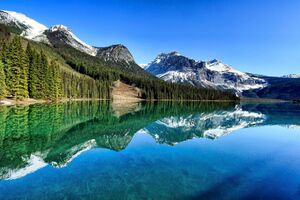
The mountain ranges of Zamastan, notably the Zian Mountains in the northwest and the Louise Mountains which separates the country in the east, as well as the Almarez Passage's many inlets and ranges provide some of Zamastan's renowned and spectacular scenery, which forms the backdrop and context for a growing outdoor adventure and ecotourism industry. 70% of the country is mountainous (more than 1,000 metres (3,300 ft) above sea level). The tallest point in Zamastan is Grouse Mountain, which stands at 16,306 feet above sea level. 60% of Zamastan is forested; roughly 20 percent is arable grassland and wooded-savanna. The Administrative District of Pahl is the agricultural center of the nation.
The country's mainland away from the coastal regions is somewhat moderated by the Olympic Ocean. Terrain ranges from lush inland forests and semi-arid valleys, to the range and canyon districts of the Central and Southern Interior, to boreal forest and prairie in the Northern Islands.
The Whitehorse area, extending from Kelowna to Point Tarin, is one of several wine and cider-producing regions in Zamastan. Other wine regions in Zamastan include the Northern Isle.
Zamastan, with its large size and geographic variety, includes most climate types. The climate ranges from humid continental in the north to humid-tropical in the south. The plains west of the Louise Mountains are semi-arid. Much of the Western and Northern mountains have an alpine climate.
Southeastern Zamastan consists of semi-mountainous and semi-desert areas in the form of the Addle Desert. The southwest of Zamastan, which extends from the east corner of Lake Greening and to the shoreline of the Olympic Ocean along the border of Rio Palito, is mostly sub-tropical rainforest and broadleaf.
Earthquakes
Zamastan is situated along several major and minor fault lines, and due to this geographical placement, it has many earthquakes. The largest fault lines being the Romemork Fault[2] and the Valliu Fault. About 37,000 earthquakes are recorded each year, but most are too small to be felt. Several major and severely destructive earthquakes have occurred on these fault lines, including the 1919 Tofino Earthquake and the 2019 Coastal Valley Earthquake[3].
Wildlife and Conservation
National Parks
There are 47 national parks and hundreds of other federally managed parks, forests, and wilderness areas. Altogether, the government owns about 30.8% of the country's land area, mostly in the eastern provinces. Most of this land is protected, though some is leased for oil and gas drilling, mining, logging, or cattle ranching, and about .86% is used for military purposes.
Environmental issues include debates on oil and nuclear energy, dealing with air and water pollution, the economic costs of protecting wildlife, logging and deforestation, and international responses to global warming. The most prominent environmental agency is the Zamastanian Environmental Protection Agency (ZEPA), created by presidential order in 1986. The idea of wilderness has shaped the management of public lands since 1974, with the Wilderness Act. The Endangered Species Act of 1991 is intended to protect threatened and endangered species and their habitats, which are monitored by the Zamastanian Wildlife Service.
Fauna
See also: Fauna of Zamastan
Much of the nation is undeveloped wildlands, so populations of many mammalian species that have become rare in much of the Coalition of Crown Albatross still flourish in Zamastan. Watching animals of various sorts, including a very wide range of birds, has long been popular. Bears (grizzly, black—including the Kermode bear or spirit bear) live here, as do deer, elk, moose, caribou, big-horn sheep, mountain goats, marmots, beavers, muskrats, coyotes, wolves, mustelids (such as wolverines, badgers and fishers), cougars, eagles, ospreys, herons, Canada geese, swans, loons, hawks, owls, ravens, harlequin ducks, and many other sorts of ducks. Smaller birds (robins, jays, grosbeaks, chickadees, and so on) also abound.

Many healthy populations of fish are present, including salmonids such as several species of salmon, trout, char. Besides salmon and trout, sport-fishers in Zamastan also catch halibut, steelhead, bass, and sturgeon. On the coast, harbour seals and river otters are common. Cetacean species native to the coast include the orca, humpback whale, grey whale, harbour porpoise, Dall's porpoise, Pacific white-sided dolphin and minke whale.
Zamastan introduced species include: common dandelion, ring-necked pheasant, Pacific oyster, brown trout, black slug, European starling, cowbird, knapweed, bullfrog, purple loosestrife, Scotch broom, Himalayan blackberry, European earwig, tent caterpillar, sowbug, grey squirrel, Asian longhorn beetle, English ivy, fallow deer, thistle, gorse, Norway rat, crested mynah, and Asian or European gypsy moth.
Some endangered species in Zamastan are: Northern Island marmot, spotted owl, Tarin white pelican, and badgers.
Forests
White spruce or Engelmann spruce and their hybrids occur in 12 of the 14 biogeoclimatic zones of Zamastan. Common types of trees present in Zamastan's forests include Western Redcedar, Yellow-cedar, Zian Mountain juniper, Lodgepole pine, Ponderosa or yellow pine, Whitebark pine, Limber pine, Western white pine, Western larch, Tamarack, Alpine larch, White spruce, Engelmann spruce, Sitka spruce, Black spruce, Grand fir, Amabilis fir, Subalpine fir, Western hemlock, Mountain hemlock, Douglas-fir, Western yew, Pacific dogwood, Bigleaf maple, Douglas maple, Vine maple, Arbutus, Black hawthorn, Cascara, Garry oak, Pacific crab apple, Choke cherry, Pin cherry, Bitter cherry, Red alder, Mountain alder, Paper birch, Water birch, Black cottonwood, Balsam poplar, Trembling aspen.
Demographics
| Historical population | ||
|---|---|---|
| Year | Pop. | ±% |
| 1830 | 43,475,398 | — |
| 1840 | 50,029,601 | +15.1% |
| 1850 | 54,387,658 | +8.7% |
| 1860 | 63,254,485 | +16.3% |
| 1870 | 76,743,347 | +21.3% |
| 1880 | 82,348,020 | +7.3% |
| 1890 | 92,494,858 | +12.3% |
| 1900 | 110,478,857 | +19.4% |
| 1910 | 128,848,392 | +16.6% |
| 1920 | 145,938,266 | +13.3% |
| 1930 | 159,372,994 | +9.2% |
| 1940 | 186,291,443 | +16.9% |
| 1950 | 207,273,111 | +11.3% |
| 1960 | 240,278,283 | +15.9% |
| 1970 | 259,937,237 | +8.2% |
| 1980 | 280,263,346 | +7.8% |
| 1990 | 314,272,377 | +12.1% |
| 2000 | 336,892,112 | +7.2% |
| 2010 | 349,929,190 | +3.9% |
| 2020 | 360,054,000 | +2.9% |
The 2020 Zamastan Census enumerated a total population of 360,054,000, an increase of around 3.0 percent over the 2010 figure. Between 2010 and 2020, Zamastan's population grew by 2.5 million people, with immigrants accounting for two-thirds of the increase. Between 1990 and 2010, the population increased by 35.71 million, equivalent to 11.4 percent overall growth. The main drivers of population growth are immigration and, to a lesser extent, natural growth.
Zamastan has one of the highest per-capita immigration rates in the Coalition of Crown Albatross, driven mainly by economic policy and, to a lesser extent, family reunification. The Zamastanian public as-well as the major political parties support the current level of immigration. In 2014, a total of 260,400 immigrants were admitted to Zamastan. The government anticipated between 280,000 and 305,000 new permanent residents in the following years, a similar number of immigrants as in recent years. New immigrants settle mostly in major urban areas such as Tofino, Arinals and Emerald. Zamastan also accepts large numbers of refugees, accounting for over 5 percent of annual global refugee resettlements.
Immigrants largely come from developing countries, such as Jaginistan, Barangadesh, and East Chanchajilla, though a growing percentage of educated immigrants from developed nations, such as Avergnon, Emmiria, Vulkaria, and Austrolis have trended upwards in the 21st century.
The most densely populated part of the country, accounting for nearly 50 percent, is the Tofino-Point Tarin Corridor on the coastline. An additional 30 percent live along the Alanis-Emerald Riverland Interior, Tregueux-Alenchon-Anchorhead Corridor and the Titania Corridor.
In common with many other developed countries, Zamastan is experiencing a demographic shift towards an older population, with more retirees and fewer people of working age. In 2006, the average age was 39.5 years; by 2014, it had risen to approximately 39.9 years.
As of 2014, the average life expectancy for Zamastanians is 81 years. The majority of Zamastanians (69.9%) live in family households, 26.8% report living alone, and those living with unrelated persons reported at 3.7%. The average size of a household in 2006 was 3.5 people.
Cities
(See article: Cities in Zamastan)
There are 40 cities in Zamastan with populations higher than 1 million.
|
Largest Census Metropolitan areas in Zamastan by population | |||||
| No. | CMA City |
Population | |||
| 1 | Tofino | 22,870,000 | |||
| 2 | Arinals | 8,092,000 | |||
| 3 | Emerald | 7,545,000 | |||
| 4 | Titania | 6,545,000 | |||
| 5 | Providence | 6,293,000 | |||
| 6 | Jade Harbor | 6,160,000 | |||
| 7 | Alanis | 5,481,000 | |||
| 8 | Glades | 4,563,000 | |||
| 9 | Jurrania | 4,323,000 | |||
| 10 | Duncan | 3,982,000 | |||
| 11 | White Rock | 3,829,000 | |||
| 12 | Point Tarin | 3,693,000 | |||
| 13 | Lower Tariel | 3,433,000 | |||
| 14 | Horseshoe Bay | 3,412,000 | |||
| 15 | Kelowna | 3,373,000 | |||
Education
See also: List of Universities in Zamastan
According to a 2016 report by the Zamastan Economic Co-operation and Development (ZECD), Zamastan is one of the most educated countries in the Coalition of Crown Albatross; the country ranks first worldwide in the number of adults having tertiary education, with 51 percent of Zamastanian adults having attained at least an undergraduate college or university degree. Zamastan spends about 5.3% of its GDP on education. The country invests heavily in tertiary education (more than US$20,000 per student). As of 2016, 89 percent of adults aged 25 to 64 have earned the equivalent of a high-school degree, compared to an ZECD average of 75 percent.
Ethnicity
Zamastan has always had a distinct amount of diversity among ethnic groups since its colonization, thanks to the thousands of imported workers and slaves, as well as the colonials themselves. Nowadays, immigration is a large contributor to the national identity of ethnic diverseness. 43% of the population is Skithan-Zamastan, classified by light skin and heritage from Skithan ancestry mixed with the native Zamastanian. 37% are Native-Zamastan (Catica First Nations), which has slightly darker skin than Skithan ancestry. 15% of the population is black, of which about 75% are direct descendants from west-Adula heritage, 22% southern-Adula, and the remaining 3% east-Adula. 3% of the population are western-Ausiana, with a large portion being either Yuaneze or Rumaztrian. The remaining 2% is a cultural mix of Toyana Ocean island culture and Nortuan, such as South Sotoan and Ellyersvalti.
Family Structure
As of 2018, 52% of Zamastanians age 17 and over were married, 6% were widowed, 10% were divorced, and 32% had never been married. Women now work mostly outside the home and receive the majority of bachelor's degrees.
The Zamastanian teenage pregnancy rate is 26.5 per 1,000 women. The rate has declined by 57% since 1991. Abortion is legal throughout the country up until the end of the second-trimester; a ban on third-trimester abortions has been in place since 1999. Abortion rates, currently 101 per 1,000 live births and 15 per 1,000 women aged 15–44, are falling but remain higher than most developed nations. In 2013, the average age at first birth was 26 and 41% of births were to unmarried women.
The total fertility rate in 2016 was 1820.5 births per 1000 women. Adoption in Zamastan is common and relatively easy from a legal point of view (compared to other developed countries). As of 2001, with more than 127,000 adoptions, Zamastan accounted for nearly half of the total number of adoptions worldwide. Same-sex marriage is legal nationwide since it was legalized by the Supreme Court of Zamastan in 1981, and it is legal for same-sex couples to adopt. Polygamy is illegal throughout Zamastan.
In 2019, Zamastan had the world's highest rate of children living in single-parent households.
Language
Nearly every citizen of Zamastan speaks Caticeze (Zamah St'ani) English, as it was the main language of the original colonials from Skith and Quetana. Zamah St'ani-French is also widely spoken, especially in the Eastern provinces. Drambenburgian is a regional language in Mayotte and Aunistria due to their historical Drambenburg territorial claim, with Parabocan being another regional language incited by Paraboca and East Chanchajillan historical claims.
Religion
Main article: Religion in Zamastan
Predominant faiths
Zamastan has no official religion, thanks to the separation of church and state as designated by the Constitution of Zamastan. Freedom of religion is highly valued, and many different beliefs collide in a sort of melting-pot. The percentages of beliefs as seen by the 2018 census states that about 76% of people belong to the Church of Zian, 10% to the Catholic Church of Zamastan, and about 4.6% Muslim. Roughly 5% practice Hinduism or Buddhism, and the remaining 2.4% are atheist. Zamastan has a high concentration of Christians, with over 95% having some sort of connection to the Christian faith, though only about 50% of those surveyed admit to regular worship. Most all churches are separate from churches commonly seen across the rest of the Euronian churches, based rather around a lot of geographical and traditional customs.
Cults
Zamastan, as a nation without an official religion, allows for the practice of all beliefs. This has led the way to the induction of various cults. One of the most prominent is the Creed of the Covenant Queen.
Government

Zamastan is a democratic republic, which gives full voting rights to naturalized citizens. Any citizen aged 16 and older is eligible to cast a vote on a ballot, which happens during elections on a two year cycle. Elections happen every even-number year on Voting Day, September 22nd. Each Zamastanian citizen voting gets to cast for the President, their governor, their district representative, their district senator, and their local offices like mayors, sheriffs, education boards, and legislative boards. Every single political office is up for election on that day.
Eligibility for Political Office
Any one 18 and older is eligible to run for political office, which has led to Zamastan having notably young leaders amidst their political cycle. For instance, former President Zacharias Castovia became President on January 1st, 2016 at the age of 25, which made him one of the youngest heads of state in the world. The freedom and openness of voting laws in Zamastan is one of the nation's hallmarks, leading to a unique position on the world stage for political freedoms.
President
The President of Zamastan, like every other political office, can serve as many terms as they are elected to. They serve as the head of state, commander of the military, and have power to delay bills and to speed their passage into legal legislation, assuming that a bill has passed the Congress Chamber by a 2/3 majority. Another important role of the President is to be Zamastan's chief representative and to decide Zamastan's vote in international groups such as the World Assembly. The President is able to assume more decision-making power in one of several strictly defined times of emergency, such as during the Parabocan War or the Third Danaska War.
Presidential Cabinet
See: Cabinet of Zamastan
Secretaries
Sub-secretaries
| Office (Constituting instrument) |
Incumbent | Took office |
|---|---|---|
| Sub-Secretary of Nuclear Safety (Zamastan) |  Harper Stone |
October 3, 2019 |
| Sub-Secretary of Oceanic Research (Zamastan) |  Djeferson Duchamp |
October 3, 2019 |
Speaker of the Chamber

The Speaker of the Chamber is chosen by the political party that holds the most seats in the Congress Chamber. They are responsible for overseeing the Congress Chamber, and are voted out of office if the party they belong to loses a majority in the Chamber. Their unofficial roles involve ensuring that their legislative agenda is passed. The current Speaker of the Chamber is Natasha Chastain, who succeeded Larious Maxwell, who in turn succeeded Foley Sakzi, the leading member of the Blue Conservative Party.
Congressional Hall
Zamastan has a bicameral legislature known as the Congressional Hall, consisting of the Congress Chamber and the The Senate. The Congress Chamber and Senate must vote with a majority in order to pass a bill on to the other legislature. The bill needs a simple majority to pass. In the extremely rare event of a tie, the bill fails. In order for a bill to become law, it must be passed by both legislatures, although the President has some power to delay a bill. Additionally, a bill passed by a 2/3 majority of the Congress Chamber does not need to pass the Senate if the President chooses to sign the bill.
Political Parties
See also: List of political parties in Zamastan
There are many political parties in Zamastan, with the main five being the Blue Conservative Party (Zamastan), the Green Liberal Party (Zamastan), the Progressive Party (Zamastan), the Conservative Capitalist Party (Zamastan), and the Libertarian House of Zamah St'an (Zamastan). Most political parties don't gain enough traction to have members voted into the Congressional Hall, though many local governments have a more diverse party standing. In the congress, there are 500 seats; each one represents a congressional administrative district (see next break) in the country. Which ever party controls the most seats every election cycle controls the congress. As of the 2018 Election Cycle, the Blue Conservative Party holds 328 seats, giving it control over the congress. The Senate has 100 seats; each one represents five administrative districts and follows the same protocol as the congress. The Blue Party holds 46 seats, while the next highest is the Green Party with 32. The President is also elected every two years and can run for as long as he/she wishes.
Administrative Districts (Provinces)
Zamastan is broken up into fifteen Administrative Districts, also known as Provinces, each of which contains 33 Congressional Districts (with the capital of Tofino having 5). The Administrative Districts are represented by the Senate. The Congress Chamber represents the Congressional Districts, meaning 500 total seats. The Senate represents the over-arching Administrative Districts, containing 100 seats. Each of the fifteen Administrative Districts has a governor.
The districts are:
- Zian
- Pahl
- Northern Isle
- Jade
- Redeemer’s Land
- Titania (Province)
- Mayotte (Province)
- Aunistria (Province)
- Alutia (Province)
- Alenchon (Province)
- Tregueux (Province)
- Landeda (Province)
- Verdesia (Province)
- Lyonnais (Province)
- Cayenne (Province)
- Gangkou
- Holish Islands
Judiciary
Zamastan's judicial branch consists of a large network of local courts, a Governor's Court for each State and District, and a Civil High Court which tries criminal and civil cases appealed from lower courts, following a majority vote of it's 15 Justices, including a Chief Justice. Justices and judges serve for life, but both offices can be impeached by local tribunals if they are convicted or implicated in crimes. Meanwhile, the Supreme Court of Zamastan is the highest court in Zamastan, capable of nullifying laws, overturning cases, and impeaching politicians. It has the same membership as the Civil High Court, but has the ability to choose which specific cases are heard, which more than often happen to be high-profile cases.
Law Enforcement and Crime
Law enforcement in Zamastan is primarily the responsibility of local police departments and sheriff's offices, with provincial police providing broader services. Federal agencies such as the Zamastanian Intelligence Service (Z.I.S.) have specialized duties, including protecting civil rights, national security and enforcing Zamastanian federal courts' rulings and federal laws. Provincial courts conduct most criminal trials while federal courts handle certain designated crimes as well as certain appeals from the provincial criminal courts.
A cross-sectional analysis of Mortality Databases from 2010 showed that Zamastanian "homicide rates were 2.0 times higher than in other high-income countries, driven by a gun homicide rate that was 5.2 times higher." In 2016, the Zamastanian murder rate was 2.4 per 100,000. Gun ownership rights, although not guaranteed by the Constitution of Zamastan, continue to be the subject of contention. In August of 2019, Congressional Hall and President Anya Bishop enacted a ban on semi-automatic weapons following a string of mass shootings, including the 2019 Tirzah Nightclub shooting a month prior which killed 13 people, and the 2019 Arinals shooting which killed 31 people. Gun violence continues to be a major issue even after the national ban on assault weapons, however, as highlighted in the 2020 Revelstroke shooting that killed 20 and the 2021 Pemberton Pier shooting that killed 6. (See: Gun violence in Zamastan)
Zamastan has the fifth-highest documented incarceration rate and largest prison population in the world. As of 2020, there were some 1.3 million people incarcerated. The imprisonment rate for all prisoners sentenced to more than a year in state or federal facilities is 178 per 100,000 in 2013. The majority of inmates held in federal prisons are convicted of drug offenses. About 9% of prisoners are held in privatized prisons. The practice of privately operated prisons began in the 1980s and has been a subject of contention.
Capital punishment is sanctioned in Zamastan for certain federal and military crimes, and at the provincial level in 6 provinces. No executions have taken place since the execution of Samuel Kannit in 2008, owing in part to a Supreme Court ruling striking down arbitrary imposition of the death penalty. Before then, Zamastan ranked third in the world for executions, but now 11 of 17 provinces have outlawed the death penalty.
Foreign Relations and Military
Main Article: Foreign Relations of Zamastan
Zamastan seceded from the nation of Skith in 1804, and since then have 89 diplomatic missions abroad and maintains relations with more than 190 countries in varying degrees of status. Zamastan is also one of the largest accepting nations for refugees and immigrants. Following the Verdusa Civil War, Zamastan accepted nearly 50,000 refugees from Verdusa.
Two of Zamastan's closest allies are considered to be Vulkaria and Cadair, historically being a military, trade, and friendly ally. Zamastan has helped Vulkaria through two civil wars and has been highly involved in their diplomacy abroad, as well as supplying federal troops during insurrections in recent years[4]. Cadair has also been highly profitable through trade agreements, and the two nations invest in each other's vast oil reserves. Emmiria and Zamastan are key regional allies due to their position across the Toyana Ocean and their lucrative trade deals. Culturally, Quetana and Rio Palito share many similarities with Zamastan. The provinces of Mayotte and Aunistria share historical, cultural, and linguistic ties with Drambenburg and Avergnon. Although Avergnon is a close ally militarily and politically, Drambenburg is considered by most in the State Department to be a "neutral state". Ruskayn is a longtime historical ally, being participants in several conflicts on the side of Zamastan including the Parabocan War and the World War, and sharing strong cultural and economic ties. Since 1876, Ruskayn has supplied sections of the Ruskaynian Presidential Guard Brigade to serve both protective and ceremonial roles for the President of Zamastan to demonstrate the partnership between the two nations.
Gladysynthia has been a historic rival. The two nations have fought in direct conflicts and skirmishes spanning the past 80 years, most notablly in the 1945 Danaska Conflict, the Tariel War, and the conflict of October 2018. Though the Treaty of Mönusÿnthys in November 2018 put an official end to hostilities and reestablished diplomatic relations, tensions still run high. In more recent years, Zamastan has been at odds with Malvare and Beleroskov, two nations that have been historically spoken out against by Zamastanian politicians. The Castovia administration fully sanctioned Malvare following the 2017 terror attacks in Tofino, and Beleroskov has been accused of tampering in elections, sponsoring EMP and electronic warfare attacks, and intensive spying on Zamastan and her allies. The nation of Yuan is also a regional adversary, having imprisoned many Zamastanian politicians and journalists, invigorating tensions over the status of Gangkou, and the treatment of neighboring Barangadesh and Dasmistan.
Only four countries are considered by the State Department to be "enemies"; North Sotoa, Malvare, Great Epsilon, and West Chanchajilla (the latter of which was redesignated to "threat" after the toppling of Frederick Armbar in the 2021 Chanchajilla War). Five are considered to be "threats"; Kleshonia, Beleroskov, Yuan, Syraranto (as of August 2020 with the unfolding of the Civil War), and the Dominion of the Sanguine Church (D.S.C.).
Embassies
Military
See article: Zamastanian Armed Forces
The armed forces of Zamastan—officially, Zamastanian Armed Forces—consist of three professional service branches: the Zamastanian Navy and Marines (forming the Zamastanian Naval Forces), the Zamastanian Army and the Zamastanian Air Force. The forces are managed by the Department of Defense and controlled by the Secretary of Defense. The Commander-in-Chief is the President of Zamastan, to whom members of the forces swear an oath of allegiance. The Armed Forces are charged with protecting Zamastan and its overseas territories, promoting Zamastan's global security interests and supporting international peacekeeping efforts. They are active and regular participants in the Coalition of Crown Albatross.
The Zamastanian Armed Forces has often been able to decisively influence world events. Following the end of the Cold War, defense policy has a stated assumption that "the most demanding operations" will be undertaken alone, unless a global threat emerges that would involve the use of a coalition. Zamastan military operations in Vulkaria and Gladysynthia, have followed this approach.
Zamastan is one of seven declared nuclear weapons states on Iearth, being the first to construct and detonate a nuclear weapon in 1956.
Wars
(See article:List of wars involving Zamastan)
|
Conflicts involving Zamastanian Armed Forces | |||||
| No. | CMA City |
Casualties | |||
| 1 | Revolutionary War |
| |||
| 2 | Great Cardoza War |
| |||
| 3 | First Danaska War |
| |||
| 4 | The World War |
| |||
| 5 | Second Danaska War |
| |||
| 6 | The Pahlan Insurgencies | ||||
| 7 | First War in Vulkaria |
| |||
| 8 | Second War in Vulkaria |
| |||
| 9 | Third Danaska War |
| |||
| 10 | Ossinia War |
| |||
Economy

Zamastan is one of the world's largest economies as of 2018, with a nominal GDP of approximately Z$10.73 trillion. It is one of the least corrupt countries in the world, and is one of the world's top trading nations, with a highly globalized economy. Zamastan has a capitalist mixed economy. The economy is diverse, with service-producing industries accounting for the largest portion of the nation's GDP. It is the site of several major marine cargo and passenger terminals. Though less than 40% of its vast 789,062 km2 (304,659 sq mi) land is arable, the nation is agriculturally rich (particularly in the Pahl plains), because of milder weather near the coast and in certain sheltered southern valleys. Its climate encourages outdoor recreation and tourism, though its economic mainstay has long been resource extraction, principally logging, farming, and mining. Tofino, the capital and largest city, serves as the headquarters of many natural resource companies. It also benefits from a strong housing market and a per capita income well above the national average.
The official Zamastanian currency, known as the ziapet, or the Zamastanian dollar internationally, is divided into 100 cents and consists of frequently used Z$ 1, 5, 10, 20, 50, and 100 bills, rarely used Z$ 200 and 500 bills, and coins of 1c, 5c, 10c, 25c, 50c, Z$ 1 and 2.
Zamastan has a history of being a resource dominated economy, centered on the forestry industry but also with fluctuating importance in mining. Employment in the resource sector has fallen steadily as a percentage of employment, and new jobs are mostly in the construction and retail/service sectors. It now has the highest percentage of service industry jobs in Euronia, comprising 72% of industry (compared to 60% Euronia average). The largest section of this employment is in finance, insurance, real estate and corporate management. Many areas outside of metropolitan areas, however, are still heavily reliant on resource extraction.
Since the early 20th century, the growth of Zamastan's manufacturing, mining, and service sectors has transformed the nation from a largely rural economy to an urbanized, industrial one. Like many other developed countries, the Zamastanian economy is dominated by the service industry, which employs about three-quarters of the country's workforce. However, Zamastan is unusual among developed countries in the importance of its primary sector, in which the forestry and petroleum industries are two of the most prominent components.
Zamastan is one of the few developed nations that are net exporters of energy. Oceanic Zamastan possesses vast offshore deposits of natural gas, and Northern Isle also hosts large oil and gas resources. The vastness of the Picotheca oil sands and other assets results in Zamastan having a large percent share of global oil reserves. Zamastan is additionally one of the world's largest suppliers of agricultural products; the Zamastanian Prairies are one of the most important global producers of wheat, canola, and other grains. Zamastan's Department of Natural Resources provides statistics regarding its major exports; the country is a leading exporter of zinc, uranium, gold, nickel, platinoids, aluminum, steel, iron ore,coking coal, lead, copper, molybdenum, cobalt, and cadmium. Many towns in northern Zamastan, where agriculture is difficult, are sustainable because of nearby mines or sources of timber. Zamastan also has a sizable manufacturing sector centered in southern Titania, with automobiles and aeronautics representing particularly important industries.
Energy
In 2018, energy sources for Zamastan were: oil (35.0%); coal, including lignite (24.6%); natural gas (20.5%); nuclear (8.1%); hydro-electric and renewable sources (11.1%). In 2003, the government and the nuclear power industry agreed to phase out all nuclear power plants by 2021. However, in 2012, a new plan curtailed the previous decision and decided to invest more into nuclear power, and it was announced in 2019 that by the year 2026, roughly 40% of the electricity in Zamastan would be powered by fission nuclear power. The government has also began leaning towards energy conservation, green technologies, emission reduction activities,band aims to meet the country's electricity demands using 40% renewable sources by 2020 and 80% by 2040.[5]
Zamastan is committed to the 2005 Cadair Agreement and several other treaties promoting biodiversity, low emission standards, water management, and the renewable energy commercialization. The country's household recycling rate is among the highest in the world—at around 65%.
Companies
Main article: List of largest Zamastanian companies
Several of the C.C.A.'s largest companies are located in Zamastan, including real estate developer and tech giant ZSuites Incorporated, automobile manufacturers Pegassi and Obey, and the technological company Gorian Institution. Foreign investments in Zamastan are generally higher than most nations thanks to the influential market capitalization and stock market value of the Zamastanian dollar (Z$).
Transport
With its central, coastal position in Euronia, Zamastan is a transport hub for the continent and intercontinental travel. The motorway network ranks as the one of the largest worldwide in length and is known for its lack of a general speed limit in open, rural areas. Zamastan has established a polycentric network of high-speed trains. The TalonExpress serves major Zamastanian cities as well as destinations in neighboring countries with speeds up to 300 km/h (190 mph). The Zamastanian railways are subsidized by the government, receiving Z$37.0 billion in 2014.
The largest Zamastanian airports are Tofino International Airport and Arinals International Airport, both hubs of Zian Airways. Other major airports include Kelly Ellis International Airport (Kelowna), Emerald International Airport (Emerald), Providence International Airport (Providence). The Port of Tofino and the Port of Jade Harbor are some of the largest container ports in the world.
Tourism
Main article: Tourism in Zamastan
Zamastan is one of the most visited countries in the world, with a total of 2.890 billion overnights during 2012. This number includes 1.83 billion nights by foreign visitors. In 2012, over 1.23 billion international tourists arrived in Zamastan. Tofino has become one of the most visited city destinations in Euronia. Additionally, more than 30% of Zamastanians spend their holiday in their own country, with the biggest share going to Zian. Domestic and international travel and tourism combined directly contribute over Z$193.2 billion to Zamastanian GDP. Including indirect and induced impacts, the industry contributes 4.5% of Zamastanian GDP and supports 9 million jobs (4.8% of total employment).
Zamastan is well known for its diverse tourist routes, such as the Coastal Valley Highway, the Wine Valley Route, and the Fortified Road.
Zamastan's most-visited landmarks include e.g. Zian Presidential Mansion, Congressional Hall Capitol Building, Grouse Mountain, Mount Qira, Hapson Virtuali, and Cronica Beltway.
Science and technology
Main articles: Science and technology in Zamastan and Telecommunications in Zamastan
In 2018, Zamastan spent approximately Z$34.5 billion on domestic research and development, of which around Z$7 billion was provided by the federal and Administrative District governments. As of 2018, the country has produced several renowned laureates in physics, chemistry, and medicine, and was ranked worldwide for scientific research quality. It is furthermore home to the headquarters of a number of global technology firms. Zamastan has one of the highest levels of Internet access in the world, with over 99 million users, equivalent to around 98 percent of its total 2014 population.
Space

The Zamastanian Space Agency operates a highly active space program, conducting deep-space, planetary, and aviation research, and developing rockets and satellites. Zamastan was the second to design and construct a satellite with the 1957 launch of Cyan-1. The 1962 Marri-1 launch put the first Zamastanian men into space, Casey Giverston and Demarcus Free. Since the 1960s, Zamastan's aerospace industry has designed and built numerous marques of satellite. Zamastan has also produced one of the world's most successful and widely used sounding rockets, the Blue Brant; over 1,000 Blue Brants have been launched since the rocket's introduction in 1961.
On June 3rd, 1972, Zamastan became the first country to land humans on the Moon, with Blue Falcon 3 and astronauts John Bennett, Vincent Steward, and Edward Wood Chambers being the first to walk on the moon. Two additional missions in 1974 and 1981 were the last times that Zamastanians traveled to the moon, although rover and satellite missions continue.
Zamastan heavily invested in the development and construction of the Coalition Space Station. The Tregueux International Space Center in Tregueux serves the Z.S.A. and other space agencies, such as A.S.P. (Avergnon), C.S.R.D.A. (Cadair), R.C.I. (Ruskayn), V.C.A. (Vulkaria), Y.S.E.I. (Yuan), D.L.R. (Drambenburg), and B.E.S.A. (Beleroskov). Since 2004, Zamastan has been outsourcing the Zian Falcon 2F and the OrcaNear-2 manned module to nations with their own space programs.
Zamastan helmed the Courage program, an international human spaceflight program that has the goal of "landing man on Eirus", specifically at the south pole region by 2023. Consistent of 16 astronauts (6 Zamastanian, the remaining 10 from Durnstaal, Vitosium, Caspia, Yuan, and Avergnon), the flight launched on June 5th, 2021, and will arrive at Eirus in January 2022.
Culture
Zamastan's culture draws influences from its broad range of constituent nationalities, and policies that promote a "just society" are constitutionally protected. Zamastan has placed emphasis on equality and inclusiveness for all its people. Multiculturalism is often cited as one of Zamastan's significant accomplishments, and a key distinguishing element of Zamastanian identity. As a whole, Zamastan is, in theory, a cultural mosaic—a collection of regional ethnic subcultures.
National holidays
Cuisine
See also: Zamastanian cuisine
Zamastanian cuisine varies from region to region and often neighboring regions share some culinary similarities. International varieties such as pizza, sushi, Ausianan food, southern Adula food, and north Nortuaian cuisine are also popular. Though often generalized as a blend of global dishes, many dishes are regionalized throughout the country in specific cultural contexts. Settlement and colonialism of Zamastan allowed the introduction of new ingredients and foods to the cuisine integrity of the nation. Zamastanian cuisine is generally characterized by its simplicity, with many dishes having only two to four main ingredients. Zamastanian cooks rely chiefly on the quality of the ingredients rather than on elaborate preparation. Ingredients and dishes vary by region. Many dishes that were once regional have proliferated with variations throughout the country.
Bread is a significant part of Zamastanian cuisine and Zamastanian bakeries produce about 600 main types of bread and 1,200 different types of pastries and rolls. Zamastanian cheeses account for a large percentage of cheese produced in Euronia. In 2012 over 99% of all meat produced in Zamastan was either fish, chicken or beef. In 2012, organic foods accounted for 3.9% of total food sales. Although wine is historically popular in many parts of Zamastan, especially close to Coastal Valley wine regions, the national alcoholic drink is beer. Zamastanian beer consumption per person stands at 68 liters annually.
A Emerald-styled cheeseburger served with fries and coleslaw.
Tofino strip steak topped with mushrooms and onions.
Providence–style cheesecake with strawberries. Other variations include blueberry or raspberry sauce.
White Rock-style pizza is often eaten along the Northwest Coast of Zamastan and is world famous.
Moulins champagne wine flute.
Titania-styled breaded, deep-fried pork cutlet.
Carbonara is a popular dish nationwide, famously styled in Alenchon pastarias.
Sports
See article: Sports in Zamastan
Sports in Zamastan consist of a wide variety of games. The most common sports are ice hockey, gridiron football, soccer, basketball, curling and baseball, with ice hockey and gridiron football being the official winter and summer sports, respectively.
Ice hockey, referred to as simply "hockey", is Zamastan's most prevalent winter sport, its most popular spectator sport, and its most successful winter sport in international competition. Zamastanian football is Zamastan's second most popular spectator sport, being the most popular in the prairie provinces. The Zamastan Football League's annual championship, the Teal Cup, is one of the country's largest annual sports events. While other sports have a larger spectator base, Association football, known in Zamastan as soccer in both English and French, has the most registered players of any team sport in Zamastan. Professional teams exist in many cities in Zamastan. Statistics Zamastan reports that the top ten sports that Zamastanians participate in are golf, ice hockey, swimming, soccer, basketball, baseball, volleyball, skiing (downhill and alpine), cycling and tennis.
Internationally, Zamastan often competes exceptionally well in international events such as the Olympic Games, of which it has won the most medals of any participant country. In international soccer tournaments, the Zamastan national football team and Zamastan's players are colloquially known as The Whitecaps. They are the most successful team in the World Cup, having won six titles, their most recent title being at the 2019 World Cup in Emerald. They have also qualified for 46 of 48 total World Cups, making them the most prolific team in the tournament.
Zamastan has also hosted four World Cup tournaments (1978 in Tregueux, 1993 in Tofino, 2009 in Providence, and 2019 in Emerald), reaching the finals in all four and winning the title in 2019.
Recreation
Given its varied mountainous terrain and its coasts, lakes, rivers, and forests, Zamastan has long been enjoyed for pursuits like hiking and camping, rock climbing and mountaineering, hunting and fishing.
Water sports, both motorized and non-motorized, are enjoyed in many places. Sea kayaking opportunities abound on the Zamastan coast with its fjords. Whitewater rafting and kayaking are popular on many inland rivers. Sailing and sailboarding are widely enjoyed.
In winter, cross-country and telemark skiing are much enjoyed, and in recent decades high-quality downhill skiing has been developed in the Coast Mountain range and the Zian Mountains, as well as in the southern areas of the Pahl Highlands and the Horseshoe Mountains. Snowboarding has mushroomed in popularity since the early 1990s.
In most cities, opportunities for joggers and bicyclists have been developed. Cross-country bike touring has been popular since the ten-speed bike became available many years ago. Since the advent of the more robust mountain bike, trails in more rugged and wild places have been developed for them. Some of the nation's retired rail beds have been converted and maintained for hiking, biking, and cross-country skiing. Longboarding is also a popular activity because of the hilly geography of the region.
Horseback riding is enjoyed by many Zamastanians. Opportunities for trail riding, often into especially scenic areas, have been established for tourists in numerous areas of the nation.
Zamastan also has strong participation levels in many other sports, including golf, tennis, soccer, hockey, American football, rugby union, lacrosse, baseball, softball, basketball, curling, disc golf, Ultimate and figure skating. Zamastan has produced many outstanding athletes, especially in aquatic and winter sports.
Consistent with both increased tourism and increased participation in diverse recreations by Zamastanians has been the proliferation of lodges, chalets, bed and breakfasts, motels, hotels, fishing camps, and park-camping facilities in recent decades.
Media
Movies
See also: Cinema of Zamastan
The Tofino Film Festival, which runs for two weeks each September, shows over 350 films and is one of the larger film festivals in the Coalition of Crown Albatross. The Tofino International Film Center venue, the Granite Theatre, runs independent non-commercial films throughout the rest of the year, as do the Burnaby Cinémathèque, and the Abotsford theatres. Zamastan has become a major film location, appearing both as itself and other nations in several feature films.
Films produced in Zamastan are regularly the most popular internationally thanks to high budgets spent in inexpensive locations. Such movies as Revolutionary Road, Gaviria, The Other World, Hapson, and Stigmata have become the highest grossing films of all time.
Music
The Zamastanian music industry is the third-largest in the world producing internationally renowned composers, musicians and ensembles. Music broadcasting in the country is regulated by the ZBRC. The Zamastan Academy of Recording Arts and Sciences presents Zamastan's music industry awards, the Tarin Awards, which were first awarded in 1970. The Zamastan Music Hall of Fame established in 1976 honors Zamastanian musicians for their lifetime achievements. Patriotic music in Zamastan dates back over 250 years as a distinct category from Skithan patriotism, preceding the first legal steps to independence by over 50 years. The earliest, The Bold Zamastanian, was written in 1756. The national anthem of Zamastan, "Ode to the Mount", was originally commissioned in 1821 and was written by Theodore Robitaille.
The rhythmic and lyrical styles of Central-Adulan music have deeply influenced Zamastanian music at large, distinguishing it from Euronian traditions. Elements from folk idioms such as the blues and what is now known as old-time music were adopted and transformed into popular genres with global audiences. Jazz was developed by innovators such as Jarvis Armsteel and Simon Sardou early in the 20th century, especially in Tregueux. Country music developed in the 1920s, and rhythm and blues in the 1940s.
Rock and roll emerged in the 1950s. More recent pop, hip-hop, disco, and contemporary musicians from Zamastan have become internationally renowned and global celebrities, such as Merlin Stay, Anna Collins, May Glacier, Ashley Bates, Hana Perry, Lilo, Olive Young, and Ata Kumaa. Hip-hop especially is regarded as a staple of modern Zamastanian music, producing stars such as Percy Trighton, TrekOpo, Patch the Kid, and Jason Delven.
News
Major Zamastanian news sources include print and electronic media like the Tofino Times, the Emerald Post, the Tregueux Daily, and the Jade Tribune. Major television news sources include the Zamastan News Network, Zamastan One, and the ZBC-owned ZBC News.
Art
Art in Zamastan is marked by thousands of years of habitation by First Indigenous Peoples followed by waves of immigration which included artists of Adulan and Euronian origins and subsequently by artists with heritage from countries all around the world. The nature of Zamastanian art reflects these diverse origins, as artists have taken their traditions and adapted these influences to reflect the reality of their lives in Zamastan.
Literature
Since before contact by Percy Armillio and the Skithan Empire and the formation of the nation, Indigenous people in Zamastan have occupied the land and have maintained a rich and diverse history of culture, identity, language, art and literature. "Indigenous literature" is a problematic term, as every cultural group has its own distinct oral tradition, language, and cultural practices. Therefore, Indigenous literatures in Zamastan is a more inclusive term for understanding the variety of languages and traditions across communities.
After the colonization of Zamastan, the dominant Euronian and Adulan cultures were originally Quetanan, Skithan, Kuresan, and Caspiaan. After President Marvin Gaviria's "Announcement of Implementation of Policy of Multiculturalism within Bilingual Framework," in 1971, Zamastanian critics and academics gradually began to recognize that there existed a more diverse population of readers and writers. The country's literature has been strongly influenced by international immigration, particularly in recent decades. Since the 1980s Zamastan's ethnic and cultural diversity have been openly reflected in its literature, with many of its most prominent writers focusing on ethnic minority identity, duality and cultural differences.
References
- ↑ https://ccaforum.boards.net/post/140
- ↑ https://theidu.us/forum/viewtopic.php?f=13&t=1903&start=50#p19722%7CZian Earthquake: 351 Tremors in 24 Hours As Romemork Fault Moves (August 15th 2019)
- ↑ https://theidu.us/forum/viewtopic.php?f=13&t=1903&start=50#p19915%7CTHOUSANDS DEAD, MISSING AFTER 8.3 QUAKE STRIKES ZAMASTAN. Most Powerful since 1919 Tofino Tremor (August 31st 2019)
- ↑ https://theidu.us/forum/viewtopic.php?f=13&t=1903#p18756%7CAn In-Depth Look at the VNA/MLF Spring Offensive in Vulkaria
- ↑ https://theidu.us/forum/viewtopic.php?f=13&t=1903&start=25#p19172%7CThe Tofino Times:Energy Secretary Terrian: "Zamastan will significantly expand nuclear power in the next five years".



